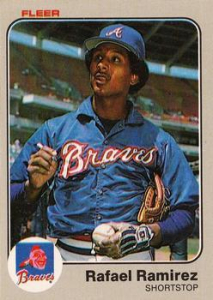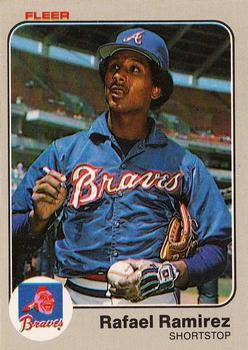April 26, 1983: Sloppy play dooms Phillies in loss to Braves
 With an eye toward returning to the top of the baseball world, the 1983 Philadelphia Phillies united three key players from the 1976 World Series champion Cincinnati Reds to boost their roster. Joe Morgan, 39 years old, was acquired from the San Francisco Giants to play second base and 40-year-old Tony Pérez, who had spent the previous three seasons with the Boston Red Sox, was signed to be a backup first baseman and pinch-hitter. They joined former Big Red Machine1 teammate Pete Rose, who celebrated his 42nd birthday in April and enlisted for another season after completing his initial four-year, $3.2 million free-agent contract with the team.
With an eye toward returning to the top of the baseball world, the 1983 Philadelphia Phillies united three key players from the 1976 World Series champion Cincinnati Reds to boost their roster. Joe Morgan, 39 years old, was acquired from the San Francisco Giants to play second base and 40-year-old Tony Pérez, who had spent the previous three seasons with the Boston Red Sox, was signed to be a backup first baseman and pinch-hitter. They joined former Big Red Machine1 teammate Pete Rose, who celebrated his 42nd birthday in April and enlisted for another season after completing his initial four-year, $3.2 million free-agent contract with the team.
With seasoned outfielders Garry Maddox and Gary Matthews and infielders Iván de Jesús and Mike Schmidt returning from the 1982 team, the majority of Philadelphia’s roster was over 30 years old. Seven members of the Opening Day roster had made their big-league debuts in 1966 or earlier. The veteran team was called the Wheeze Kids by Philadelphia Phillies President Bill Giles in homage to the National League champion 1950 Phillies.2 (With a roster dominated by young players, the 1950 team was commonly known as the Whiz Kids.3)
The Phillies were off to a quick start when they met the defending National League West Division champion Braves in Atlanta on April 26. Philadelphia had won nine of its last 11 games, including a split of a two-game set with the Braves at Philadelphia’s Veterans Stadium. The first-place Braves were 12-3, winning all nine games played at Atlanta-Fulton County Stadium. On a warm Tuesday evening in front of a crowd of 22,511, each team hoped to continue its winning ways.
Atlanta starter Pascual Pérez had allowed just two earned runs in his first three starts, including a win in Philadelphia on April 17, but the Phillies jumped on him for three first-inning runs. With one out, Matthews singled and Morgan walked, bringing cleanup hitter Schmidt to the plate. In his 12th season with the Phillies, the 33-year-old third baseman worked the count to 2-and-2,4 then reached for a slider on the outside of the plate and drove the pitch over the left-field wall for a three-run homer, the 355th of his major-league career.
The Braves quickly knotted the score in the bottom of the inning. Brett Butler started the rally with a single to right off Phillies starter Larry Christenson, who had not pitched in eight days because of a hamstring problem. Rafael Ramírez followed with a single to center that eight-time Gold Glove winner Maddox could not field cleanly. Butler scored on the error and Ramírez took second. After Claudell Washington flied out to left, reigning National League MVP Dale Murphy lined a home run down the right-field line to even the game, 3-3. Praising his young outfielder, Braves manager Joe Torre said, “The guy doesn’t know how strong he is.”5
The Braves continued to bludgeon Christenson in the second inning. Bruce Benedict scorched a double to left, then Pascual Pérez pushed a bunt to the third-base side of the mound. Christenson fielded the bunt and made an off-balance throw to first that bounced away from Tony Pérez. Pascual Pérez was safe at first on the error. After Butler singled to left to load the bases, Phillies manager Pat Corrales removed Christenson from the game. “It showed that [Christenson] hadn’t pitched in over a week because he was up with his pitches and the Braves were right on everything,” Corrales said.6
Ed Farmer was replaced Christenson. The 33-year-old right-hander had pitched with seven different teams since his rookie year of 1971 and was in his second stint with the Phillies. The Braves continued the onslaught with three straight singles. Ramírez’s hit drove in Benedict and Pérez, and Washington’s loaded the bases again. Murphy plated Butler and Ramirez with his drive up the middle, and Washington landed on third.
Bob Horner smoked a liner that caromed off Farmer’s left wrist. De Jesús picked up the ball and threw to catcher Bo Diaz, who tagged the sliding Washington for the first out. Chris Chambliss lifted a drive to center that Maddox caught for the second out.
Glenn Hubbard grounded toward second baseman Morgan and it looked as though the inning would be over, but Morgan booted the ball. Murphy, running from second at the crack of the bat, scored easily. Benedict walked to load the bases again, but Pascual Pérez dribbled a ball to Farmer, who tossed it to first for the third out. The Braves sent 11 men to the plate in the inning, scoring five runs to take an 8-3 lead.
The Phillies got one run back in the top of the third. With one out Matthews singled to left and Morgan walked. Schmidt struck out, but Tony Pérez singled to center to drive in Matthews.
The score remained 8-4 until the sixth. Pascual Pérez retired the Phillies in order in the fourth and fifth innings while Farmer and Porfi Altamirano held the Braves scoreless.
The Phillies put up one last gasp in the sixth inning. Tony Pérez walked and Diaz and Maddox singled to load the bases. Manager Corrales inserted lefty Von Hayes to hit for de Jesús. Although the 24-year-old Hayes—acquired in a December 1982 trade that sent five players to the Cleveland Indians—was not playing in the field due to a sore arm, he could still hit. When Hayes was announced, Torre countered by pulling Pascual Pérez from the game in favor of southpaw Terry Forster. Playing the percentages, Corrales replaced Hayes with righty Bill Robinson.
Corrales’s move failed as Forster struck out Robinson for the second out. Corrales made one more change, substituting switch-hitter Larry Milbourne for Altamirano. Milbourne lined a shot to deep left that Murphy grabbed in front of the fence with a leaping catch, leaving the bases loaded and extinguishing the rally.
Forster pitched the rest of the game, surrendering just two hits in the final 3⅔ frames while collecting two hits himself. Both hits played a prominent role in the final runs scored by the Braves. In the sixth inning with Tug McGraw pitching and Hubbard on first with a one-out single, Forster—a .397 hitter in 78 at-bats over 16 big-league seasons—doubled to left. Hubbard headed for home, and when Diaz failed to catch the throw from Matthews, Hubbard was safe at home on Philadelphia’s fourth error of the night. The Braves’ lead was 9-4.
McGraw pitched though the seventh, surrendering four hits and one unearned run in his two innings. Bob Dernier pinch-hit for McGraw in the seventh and Sid Monge was the new Phillies’ pitcher in the eighth. With two outs, Forster and Butler hit back-to-back singles. Ramirez lined his fourth hit of the night—and Atlanta’s 19th overall—a single to center.
Maddox charged the ball, but it took a bad hop, allowing Forster to score the unearned run on the center-fielder’s second error and the Phillies’ fifth of the game. A frustrated Maddox said, “The only way to keep from making errors in this park is to wait until the ball stops rolling.”7 The Braves had their final run in a 10-4 win.
Corrales was not happy with his team after the game. “You can write off this whole game to a lack of concentration,” he said. “They beat the hell out of us and we played like horsebleep.”8
On the other side of the field the Braves were celebrating their 10th straight victory at home to start the season, tying a club record set in 1966, their first season in Atlanta. “When you win on one of Pascual’s bad nights, you know you’re going good,” said Torre.9
The Wheeze Kids floundered around .500 the first half of the season. On July 18, with the Phillies tied for first place in the NL East but only one game over .500, general manager Paul Owens fired Corrales and assumed the managerial reins. Philadelphia’s experienced roster eventually surged in September to an 11-game winning streak, and pulled away from a tight pack for the Phillies’ fifth division title in eight seasons. Like the 1950 Whiz Kids, the 1983 Phillies advanced to the World Series before succumbing to the American League champion Baltimore Orioles.
Acknowledgments
This article was fact-checked by Mark Richard and copy-edited by Len Levin.
Sources
In addition to the sources cited in the Notes, the author consulted Baseball Reference and Retrosheet for information including the box score and play-by-play.
https://www.baseball-reference.com/boxes/ATL/ATL198304260.shtml
https://www.retrosheet.org/boxesetc/1983/B04260ATL1983.htm
Notes
1 Dan Flaherty, “A Big Red Machine Reunion with the 1983 Philadelphia Phillies,” thesportsnotebook.com, accessed April 18, 2023, https://thesportsnotebook.com/1983-philadelphia-phillies-sports-history-articles/.
2 Steve Wulf, “In Philadelphia, They’re the Wheeze Kids,” Sports Illustrated, March 14, 1983, https://vault.si.com/vault/1983/03/14/in-philadelphia-theyre-the-wheeze-kids.
3 The term was first applied during 1950 spring training by Harry Grayson, sports editor of the Newspaper Enterprise Association, a news syndicate. Karen Guenther, “Whiz Kids,” The Encyclopedia of Greater Philadelphia, East Brunswick, Rutgers University: 2017, https://philadelphiaencyclopedia.org/essays/whiz-kids/.
4 Bill Conlin, “Phils Experience Is Worst of Times,” Philadelphia Daily News, April 27, 1983: 76.
5 Chris Mortensen, “Braves Tie Record by Routing Phils,” Atlanta Constitution, April 27, 1983: D1.
6 Peter Pascarelli, “Hot Braves Thrash Phillies Pitchers for 19 Hits and Ease to 10-4 Victory,” Philadelphia Inquirer, April 27, 1983: C1.
7 Conlin.
8 Pascarelli.
9 Mortensen.
Additional Stats
Atlanta Braves 10
Philadelphia Phillies 4
Atlanta-Fulton County Stadium
Atlanta, GA
Box Score + PBP:
Corrections? Additions?
If you can help us improve this game story, contact us.


